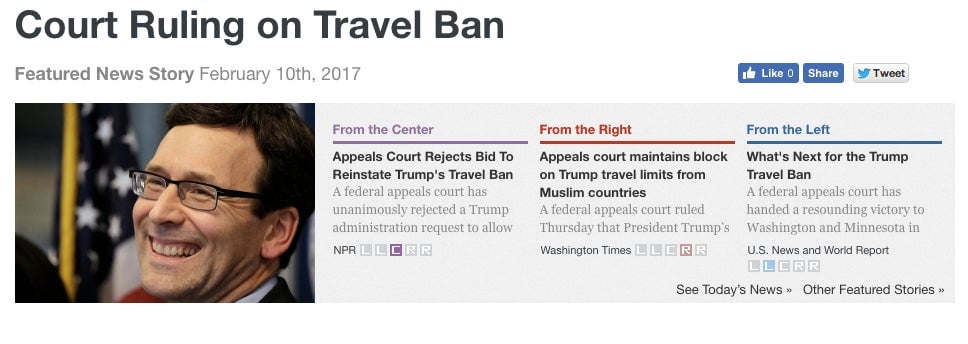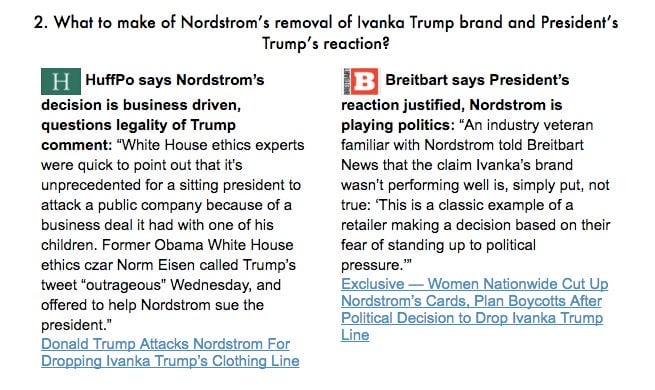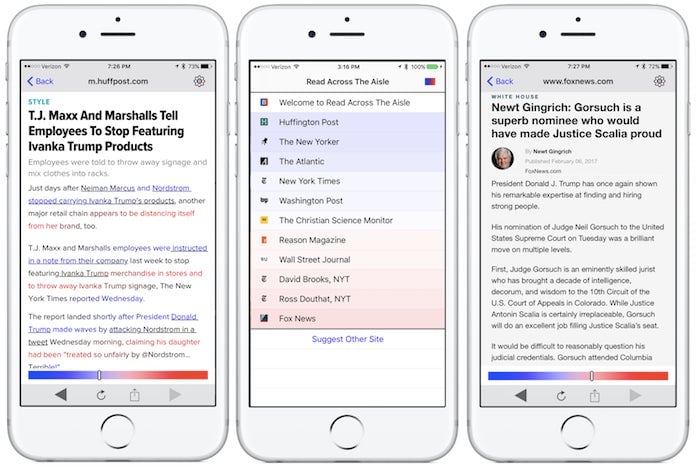A complete guide to seeing the news beyond your cozy filter bubble
Depending on where you fall on the political spectrum, your social-media feed on Feb. 17—when US president Donald Trump gave an unwieldy 77-minute press conference—may have been filled with posts like this:


Depending on where you fall on the political spectrum, your social-media feed on Feb. 17—when US president Donald Trump gave an unwieldy 77-minute press conference—may have been filled with posts like this:
Or this:
In all likelihood, you’re not seeing both.
According to Eli Pariser, who authored the 2011 book The Filter Bubble, an already-divided public is becoming even more so as people increasingly use algorithm-driven platforms like Facebook to consume news.
These algorithms aim to serve consumers content that is most relevant to their lives and preferences. In the case of news, if you consistently click on stories with either a liberal or conservative bent, you will prime the algorithm to serve you similar stories in the future—with other views filtered out.
Content producers are also learning to manipulate these algorithms, by framing stories that play directly into existing partisan narratives, often to maximize clicks—but sometimes with nefarious intent (see: fake news).

Whatever your political beliefs, it can be hard work to evade the algorithms and seek out stories and perspectives that challenge your own. But it’s crucial for the vitality of democratic institutions that rely on an engaged, heterogeneous public.
Here’s how you can do it for yourself.
Don’t burst your bubble all at once
To get started, Pariser cautions against “overcorrection,” and suggests reading the work of ”bridge figures,” like columnists who hold moderately different views from your own. This will help guard against the cerebral whiplash you may feel if you jump straight from one partisan extreme to the other.
“There’s a tendency to go right to the opposite strand, like ‘if I lean left, then I’m going to start reading Breitbart,'” he says. “That doesn’t end very well and will generally make people unhappy and upset.”
If you are looking for moderately conservative voices, try reading Joseph Rago (paywall) of the Wall Street Journal or Caroline Baum of MarketWatch. For a moderately liberal perspective, Political Gabfest or Vox’s The Weeds podcast are two options.

Once you feel comfortable with these moderate voices, you can push yourself to stray further to the other end of the spectrum. For “alt-right” and conservative perspectives, I curated this Twitter list, while Slate has this one of ”left-leaning” tweets.
If you use a Twitter client like Tweetdeck or Hootsuite, try adding these lists as columns in the center, so they are impossible to miss. If you’re not a Tweetdeck fan, you can create a folder of bookmarked websites in your web browser. Consider setting a desktop notification that will remind you to check these sites on a regular basis.

Another resource is the website Allsides.com, which presents left, right and center perspectives on issues in the news in a way that’s visually easy to track.
While you can learn the most from reading each article in succession, even looking at the headlines next to each other can be illuminating if you were previously getting only one side of the story.
Get new perspectives in your inbox
E-mail newsletters are another simple way to incorporate new views into your media diet.
Since 2015, journalist Will Sommer, who grew up in Texas and is now an editor for the Hill has curated the weekly newsletter, Right Richter, a ”media digest for people who don’t usually consume right-wing news.”
“Breitbart is literally in the White House right now,” Sommer said. “So all the better to commit to a better understanding for the next four to eight years.”
Sommers’ roundup chronicles the best of the week in GOP news and talk radio, including stories that have been debunked and the occasional “word watch.”

Another option, PolarNews, was developed by students at the Wharton School at the University of Pennsylvania who were surprised by the outcome of the UK’s Brexit referendum.
The daily newsletter gives readers a pair of divergent perspectives on topics that have made the US news—from Lady Gaga’s half-time show at the SuperBowl to the implications of Trump’s SCOTUS pick.
Make looking ‘across the aisle’ a habit
Perhaps the most critical step you can take to get past your filter bubble is to seek out alternative viewpoints on a regular basis. A new app can help you take a ‘quantified self’ approach to the problem.
“Read Across the Aisle,” which launched on Feb. 21, aims to be a FitBit for responsible news consumers, says creator Nick Lum.
“If at 4 p.m. you’re taking the stairs because you know you won’t make your goal for the day, this is the same thing for your balanced news diet,” Lum says. “If you’ve been reading all on one side, reminders will let you know that you should try reading something on the other side.”

While perusing the news on the app, a blue-to-red meter tracks how frequently you seek out partisan sources. If you’re leaning a little too far in either direction, you can make adjustments as you go.
“Social media makes it really easy to feel like you’ve got enough news for the day, but it’s all coming from one side for many people,” Lum said. “This tool that is aimed at people who realize that they’re in a bit of a bubble, and want to get out and want something to get them to do it on a regular basis.”
Lum also compiled this list of resources to help news consumers move past the filters, including a Chrome extension called “Escape Your Bubble” that inserts positive stories about either Democrats or Republicans into your Facebook feed.
If you find other tips or tools to burst your filter bubble, please let me know what you come up with. And once your media habits become more balanced, you could also consider more direct outreach with people on the other side of the aisle. You never know what you might learn.
As journalist Chris Baraniuk wrote for Quartz in November, “The best way to exit an echo chamber or throw off the blinders of prejudice is still by willingly exposing ourselves to people and ideas that challenge us.”